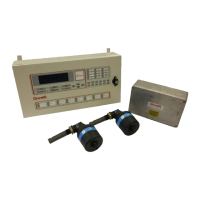Note: When the engine is started from cold in Arctic/Antarctic conditions, a water mist can be produced
that could give a false alarm.
All events are stored in the alarm/fault queue in order of occurrence. The user can scroll through the
queue by use of the arrow keys.
Once an event is active the event is displayed on the LCD in the appropriate format. To clear the display
press the ACCEPT key. Once the ACCEPT key is pressed, the display shows the ENGINE AVERAGES
display.
Figure 112 Accepted Alarms
3.11.2 Average Alarm
Following each scan of the Detectors the Control Panel calculates the average oil mist level for each
engine. If the calculated average oil mist level rises above the set average alarm level an average alarm
condition will be initiated. This is indicated by:
Detector Alarm LED on
Control Panel Activation of the Common Alarm Relay and the relevant
engine Shutdown / Slowdown Relay.
Buzzer sounding.
Alarm indicator LED on
Relevant engine Alarm LED on
Alarm indicated on the LCD.
The bar graph for the engine will be displayed on the LCD.
If more than one engine is in alarm the screen will cycle
between engines.
Following acceptance of the alarm the buzzer will silence and the common alarm relay is deactivated.
Pressing reset will clear the alarm and return the Control Panel to the normal state.
3.11.3 Deviation Alarm
Following each scan of the Detectors the Control Panel compares the individual detector oil mist reading
with the engine average oil mist level. If the detector reading exceeds the engine average level by more
than the set deviation alarm value, then a deviation alarm is initiated. This is indicated by:
Detector Alarm LED on
Control Panel Activation of the Common Alarm Relay and the relevant
engine Shutdown / Slowdown Relay.
Buzzer sounding.
Alarm indicator LED on
Relevant engine Alarm LED on
Alarm indicated on the LCD.
The bar graph for the engine will be displayed on the LCD
with the detector in alarm flashing. If more than one
engine is in alarm the screen will cycle between engines.

